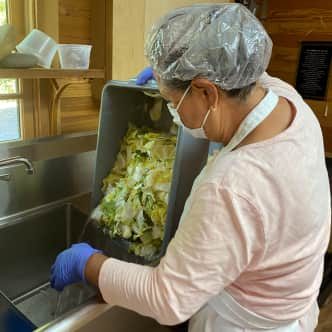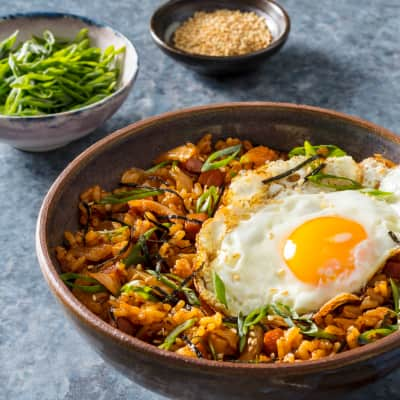Every Saturday, Jeisook Thayer starts making tongbaechu-kimchi in the tidy basement kitchen of her Vineyard Haven home.
The Business and Culture of Kimchi: A Chat with Jeisook Thayer
Published Dec. 7, 2020.

Working with about 35 pounds of napa cabbage, she chops the leaves and salts them overnight, making sure to flip them halfway through salting so that they brine evenly. The next day, she thoroughly tosses the wilted cabbage with chopped ginger, garlic, scallion, gochugaru, and a little water; tightly packs the mixture into a pair of food-grade buckets, weighing it down with flat, heavy stones to press out as much air as possible; covers it; and leaves it to ferment for the better part of a week.
When it’s ready—she can tell because the cabbage has “a little bit of effervescence,” indicating that yeasts are digesting sugars and producing carbon dioxide gas, as well as “a little bit of tanginess”—she divides the pickle into pint-size deli containers and delivers them to a handful of local markets.


To make the seasoning mixture, Thayer finely chops the ginger and garlic in the food processor, then tosses those aromatics with gochugaru and scallion lengths.


After salting the cabbage overnight and draining it, Thayer thoroughly mixes the wilted leaves with the seasonings.


The fermentation process begins when Thayer packs the seasoned cabbage into food-grade buckets and weighs it down with flat stones.
Thayer started her one-woman business, MV Kimchi, as a retirement project but also as a way to “introduce people to what kimchi really is.” She considers it her contribution to the small island community, and it’s unmistakably a small form of kimjang (also spelled gimjang), the age-old ritual of making and sharing kimchi.
“In the old days,” Thayer recalls of the fall kimjang seasons during her childhood in Seoul, “if you live next door to me, today might be my day, so there will be a truckload of cabbage will come dump on my yard. All my neighbor women and children will come salt the cabbage. It’s an all-day—a couple of days—event. After you make all mine, and I have enough to feed my family for the winter, then maybe it’s your turn and we’ll all go to your house. We’ll all do it together . . . that’s my memory of making kimchi.”
The collective work is an efficient way to preserve a harvest’s worth of vegetables. But writers and scholars who talk about kimjang culture are quick to point out that it’s even more about sharing and community. In fact, those ideals are so foundational to Korean culture that in 2013, “kimjang—making and sharing kimchi” was registered with the United Nations Educational, Scientific and Cultural Organization (UNESCO) as an Intangible Cultural Heritage tradition.
This profile is part of the research we did for our Kimchi Bokkeumbap article and recipe.

